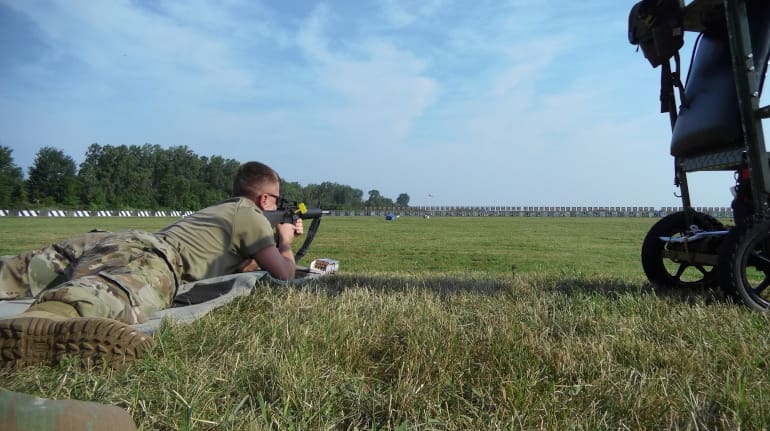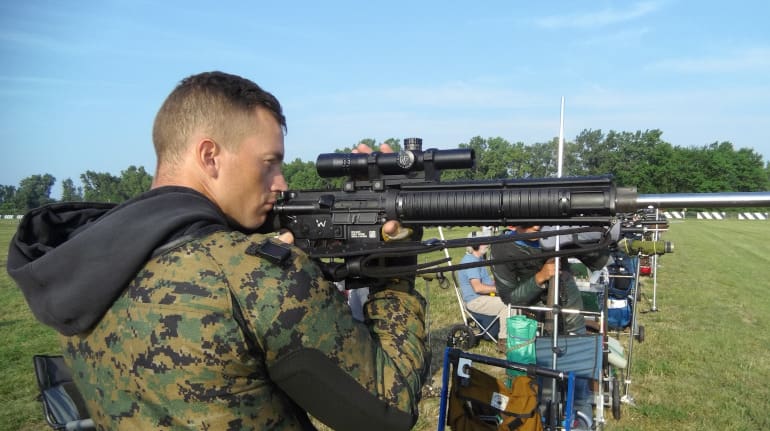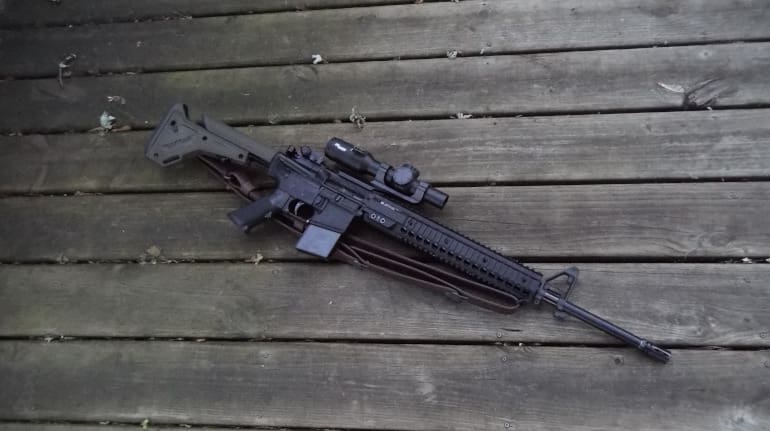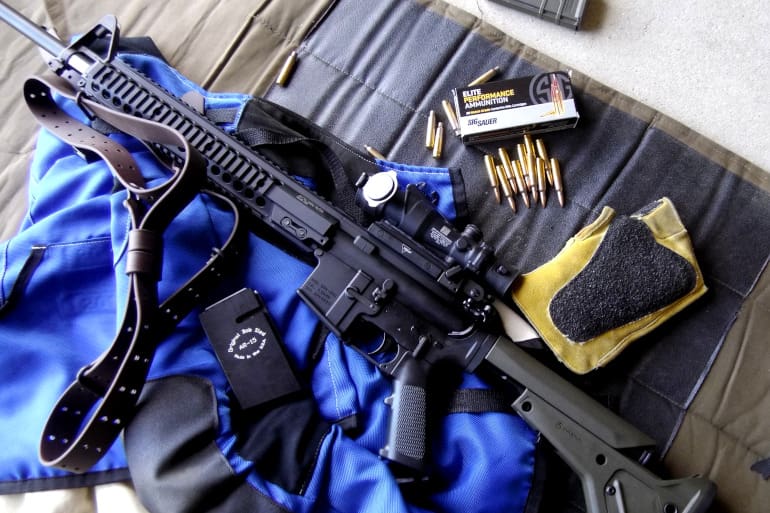In the last two articles in this series, I talked about the history of the President’s 100 match run by the Civilian Marksmanship Program and also built a rifle legal for the matches with the help of Brownell’s. Today we are going to be talking competition optics and ammunition and some ideas taken right from the firing line at Camp Perry.
Match Ammunition
The first thing we will look at is the ammunition and general ideas behind what you need to play the game. There are really only two ways to go: handloads or factory ammo. While it may be a no-brainer to some people to squeeze out custom performance using handloads, there are a fair number of competitors who don’t have the time or desire to make their own ammo and thus must find suitable factory loads.
I talked to shooters of all ages and skill levels when I was at Camp Perry and I found that most were using some sort of handload, but there was some division as to what exactly that means.
Some shooters used a different load for each distance shot in the match: 200, 300, and 600 yards. Most used two loads, one for 200 and 300 and a separate formulation for 600. It was rare to find shooters that used one handload across the board.

Bullet Weights
Virtually all shooters were using 75-77gr bullets at 200 and 300 yards. These were supplemented by 80-85gr bullets for 600 yards. Most of these rounds were loaded long to take advantage of modern VLD (very low drag) bullets with the exception of the ammunition used for the 300 yard rapid fire stage, which requires the use of magazines and thus ammunition loaded to a length that allows for reliable feeding.
I spoke to only two competitors who used lighter bullets for 200 yard offhand shooting. Both used 69gr Sierra MatchKings. The difference in recoil isn’t tremendous, but they claimed it to be worth it for even a couple less foot-pounds when firing from standing.

The other option here is to go the factory route, which I did to better represent what a walk-on would use who had limited time and resources to practice. I had never fired in a modern service rifle match before, so I wanted to do it just as a novice would despite my access to reloading equipment, bullets and powder.
I’ll spare you the details, but I ended up picking a single load for all distances and it’s one that I am sure you will recognize: the Black Hills MK262 Mod1. This is a 77gr load that is essentially the same as the great military stuff with the exception of the packaging. Look for a full and detailed review of this ammunition here on TTAG very soon. It’s some of the very best 5.56mm available today and it has a wide range of end uses.

This ammunition was very accurate in the rifle I built with supplies from Brownell’s. I tested a number of different types of ammo in the rifle and was pleased to find that the MK262 was both accurate and fast enough to be suitable for use at Camp Perry. I had great success with other ammo as well, but the MK262 was the best of all worlds when all the factors were considered.
Optics Choices for the President’s 100
Optics are a whole story on their own. There have been a great number of products that suddenly emerged when the CMP changed the Service Rifle rules to allow optics. The optics can have a maximum magnification of 4.5x. There are some restrictions on the physical size of the scopes used, but most normal 4x scopes made for AR rifles will work. The objective lens cannot be larger than 34mm.

There are generally a couple ways to go with this: Commercial or military. The ‘military’ option is what I’m defining as optics like the fixed magnification ACOG, which are very common in local matches, but rare at Camp Perry. There are a couple of pros and cons to each of these types of optics, and they’re valid depending on what you are looking to do.
The commercial optics available specifically for Service Rifle are many. Leupold, Nightforce, March, Hi-Lux, and others make excellent match-legal optics.
I tested out a newcomer that worked very well: the SIG SAUER Tango4 mil/mil First Focal Plane. The major difference between commercial and military optics is about philosophy of use, available range and local requirements.

Some shooters with ACOG sights loved the optic for its durability and great optical clarity. These shooters tended to be visitors to the National Matches and shot using a set zero and simple holdovers.
These shooters generally zeroed at 300 yards for rapid fire point-blank and held low at 200 for offhand. Six hundred yards is done with a holdover point, although that may not be the ‘600’ mark on the reticle itself. The ACOG shooters typically used one type of ammo for all distances.
The commercial scope shooters made up the vast majority of shooters on the line at Camp Perry. These scopes typically have longer eye relief than the ACOG and thus can allow for a lower head position and more comfortable shooting. These scopes are able to be mounted forward of the receiver in a mount like the Creedmoor Sports version I used.
Iron sights are also quite usable and a number of shooters still compete with them. What? Six hundred yards with iron sights? It is not at all impossible and was standard practice up until the CMP changed the Service Rifle rules in 2016.
Can a shooter still be competitive with irons? They sure can. I find that irons are easier in offhand, but that’s just me. Others are free to disagree.

Overall there’s a great deal to look at when deciding what you’ll use to sight in your target. There isn’t really a wrong answer to the ammo and optics questions and it’s really about what you’re used to and what you’re looking to get out of the deal.
If you want to go to Camp Perry with a replica M16 and all the correct markings, gear, and an ACOG, you’re totally able to do that. If you want to build a dedicated match gun and use the most up-to-date competition scope available, feel free to do exactly that.
I think that you will see more and more optics in Service Rifle competition, as well as more dedicated ammo loads. That said, I chose to go factory to see what would happen without specialized ammo or other equipment. Everything I used in these articles is commercially available now and you can be competitive using exactly what I used with the right practice.





Anybody chrono’d the difference between Black Hills and IMI Mk262 Mod 1 loadings? From what I can tell, the IMI stuff is top notch. I got a brand new bayonet chrono this week, so hopefully I’ll be able to get some good full box velocity and SD data.
I haven’t compared the two, but I’ve been happy with the IMI stuff. It chronos pretty consistently and prints about .7 MOA. I use the 69gr load for open match stuff, and general long range stuff. It zeros the same as Fed Fusion for my 20″ AR.
This is so stupid! Find a load that shoots great at 600 yards and go with that. In the real world you wouldn’t change out loads during a fire fight or while taking a game animal. What ever floats your boat but in the real world simple is always better.
The loads that shoot great at 600 won’t fit in a magazine. Since you single load anyway and have 1 minute per shot, why not use the best ammo you can? NM shooting isn’t combat shooting anyway.
Well, because this is neither hunting nor a fire-fight; it is infact a competition. Do you know how big the aiming black is? How about the xring? The margin of error between scores at 600 yards gives the edge to high BC bullets, not to mention the fact that the slow fire stage is single-load only so magazine length restrictions don’t matter.
I shoot Hornady 75 HPBTs loaded to magazine length across the course. My problems aren’t at the 600 yard line, they’re mainly at the 200 and 300 yard lines. A lot of guys put a ton of emphasis on fine tuning loads for tiny gains when they should be putting emphasis on fine tuning their positions instead.
A few years back I got talking to an AMU shooter after the match and they were shooting Hornady 75 HPBT bullets across the course. They were loading their 200 and 300 yard loads to magazine length and loading their 600 yard line loads out closer to the lands. I don’t think they’re using 75s anymore but I haven’t really inquired about it either. The lighter bullets didn’t seem to be much of a disadvantage for them.
It would be exciting to see the competition evolve in the future to possibly accommodate the new Army service rifle that’s up for bid, given it passes service trials and goes into production. A newer, more capable 6mm cartridge variant of 110-140gr would be a great for a 600m or even 800m distance match.
Still, it’s interesting to what’s going on in the 5.56mm world with those modified rifles. As times change what will those sharpshooters be choosing?
Jeez, still?
essay代写 031
Comments are closed.